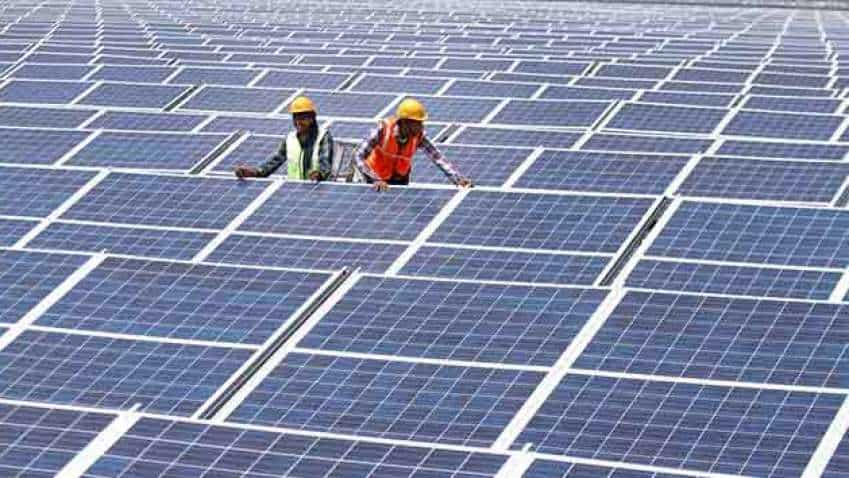UN climate summit: At 45 GW, India's solar energy capacity increased 17 times in 7 years
India on Sunday told the UN climate summit here that its solar energy capacity stands at about 45 gigawatts after it increased 17 times in the last seven years, asserting that although the country represents 17 per cent of the global population, its historical cumulative emissions are only 4 per cent.

India on Sunday told the UN climate summit here that its solar energy capacity stands at about 45 gigawatts after it increased 17 times in the last seven years, asserting that although the country represents 17 per cent of the global population, its historical cumulative emissions are only 4 per cent.
India said this while giving a presentation on its third Biennial Update Report (BUR) during the 11th Facilitative Sharing of Views (FSV) at the ongoing COP26 climate summit here.
See Zee Business Live TV Streaming Below:
The BUR was submitted to the United Nations Framework Convention on Climate Change (UNFCCC) in February.
The key highlight of the discussion on India's third BUR was the achievement of 24 per cent reduction in emission intensity of its Gross Domestic Product (GDP) over the period of 2005-2014, and the significant increase of its solar programme.
Making a statement on behalf of India, J R Bhatt, Adviser/Scientist in the Ministry of Environment, highlighted that India represents 17 per cent of the global population but its historical cumulative emissions are only 4 per cent, while current annual greenhouse gas (GHG) emissions are only about 5 per cent.
This is complemented by the fact that India is particularly vulnerable to climate change. However, India is nevertheless taking several mitigation actions, spanning across the entire economy and society and has progressively continued decoupling of its economic growth from greenhouse gas emissions,? said Bhatt.
In the last seven years, India's installed solar energy capacity has increased 17 times, he said, adding that the solar energy capacity now stands at about 45 gigawatts.
All the Parties commended India's efforts on the BUR and its climate actions, including recent announcements of new measures.
There were questions about India's multilateral efforts to combat climate change, including the Coalition for Disaster Resilient Infrastructure (CDRI).
India responded by saying that disaster risk is increasing in developing countries, and this is a step to enhance international cooperation which is much needed in the current times.
On the question of an increase in forest cover, India responded that people's participation has played an important role in enhancing its forest cover, and that its forests provide all the four ecosystem services.
India highlighted that it speaks on climate change from a position of strength and responsibility.
India's 15 per cent of total carbon dioxide emission in 2016 was removed from the atmosphere by the LULUCF (Land Use, Land-Use Change and Forestry).
Between 2015 and 2019, the forest and tree cover increased by 13,031 square kilometer and mangrove cover increased by 235 square kilometer. Populations of Asiatic lion, elephant, rhino increased manifold in the last 5 to 6 years,? according to India's statement.
We emphasise that India is particularly vulnerable to climate change, a point which many friends overlook in their eagerness to understand our mitigation efforts.
To follow a sustainable path to development, India has taken several mitigation actions. There is no sector that has been left untouched while planning and implementing climate mitigation actions. They span across the entire economy and society,? it added.
Get Latest Business News, Stock Market Updates and Videos; Check your tax outgo through Income Tax Calculator and save money through our Personal Finance coverage. Check Business Breaking News Live on Zee Business Twitter and Facebook. Subscribe on YouTube.
RECOMMENDED STORIES

Largecap Stocks To Buy: Analysts recommend buying Maruti Suzuki, 2 other stocks for 2 weeks; check targets

Top 7 Index Mutual Funds With Best SIP Returns in 10 Years: Rs 11,111 monthly SIP investment in No. 1 fund is now worth Rs 33,18,831; know how others have fared

Shark Tank India Season 4: Social Media influencer Gaurav Taneja shocks sharks with his earnings, earns Rs 1 crore in 1 hour!

SIP in Stocks For New Year 2025: Market guru Anil Singhvi recommends 1 largecap, 2 midcap scrips to buy in dips; note down targets

Largecap PSU Stock for 65% Gain in New Year: Anil Singhvi picks PSU bank for long term; know reasons and target prices

SIP Stock Pick For New Year 2025: Anil Singhvi recommends buying this largecap pharma stock on 10% dip

PPF vs SIP: Rs 12,000 monthly investment for 30 years; see which can create higher retirement corpus
05:22 PM IST








 118% return in 1 year: Solar stock hits upper circuit - Check details
118% return in 1 year: Solar stock hits upper circuit - Check details  Gensol Engineering secures Rs 463 crore solar plant project at Gujarat's Khavda RE Power Park
Gensol Engineering secures Rs 463 crore solar plant project at Gujarat's Khavda RE Power Park Zero Carbon Emission: This steel manufacturer announces decarbonisation of manufacturing facilities
Zero Carbon Emission: This steel manufacturer announces decarbonisation of manufacturing facilities India adds record 10 GW of solar capacity in Q1 2024, marking almost 400% YoY increase
India adds record 10 GW of solar capacity in Q1 2024, marking almost 400% YoY increase Rajasthan government signs 5 MOUs worth Rs 1.60 lakh crore to boost energy sector
Rajasthan government signs 5 MOUs worth Rs 1.60 lakh crore to boost energy sector